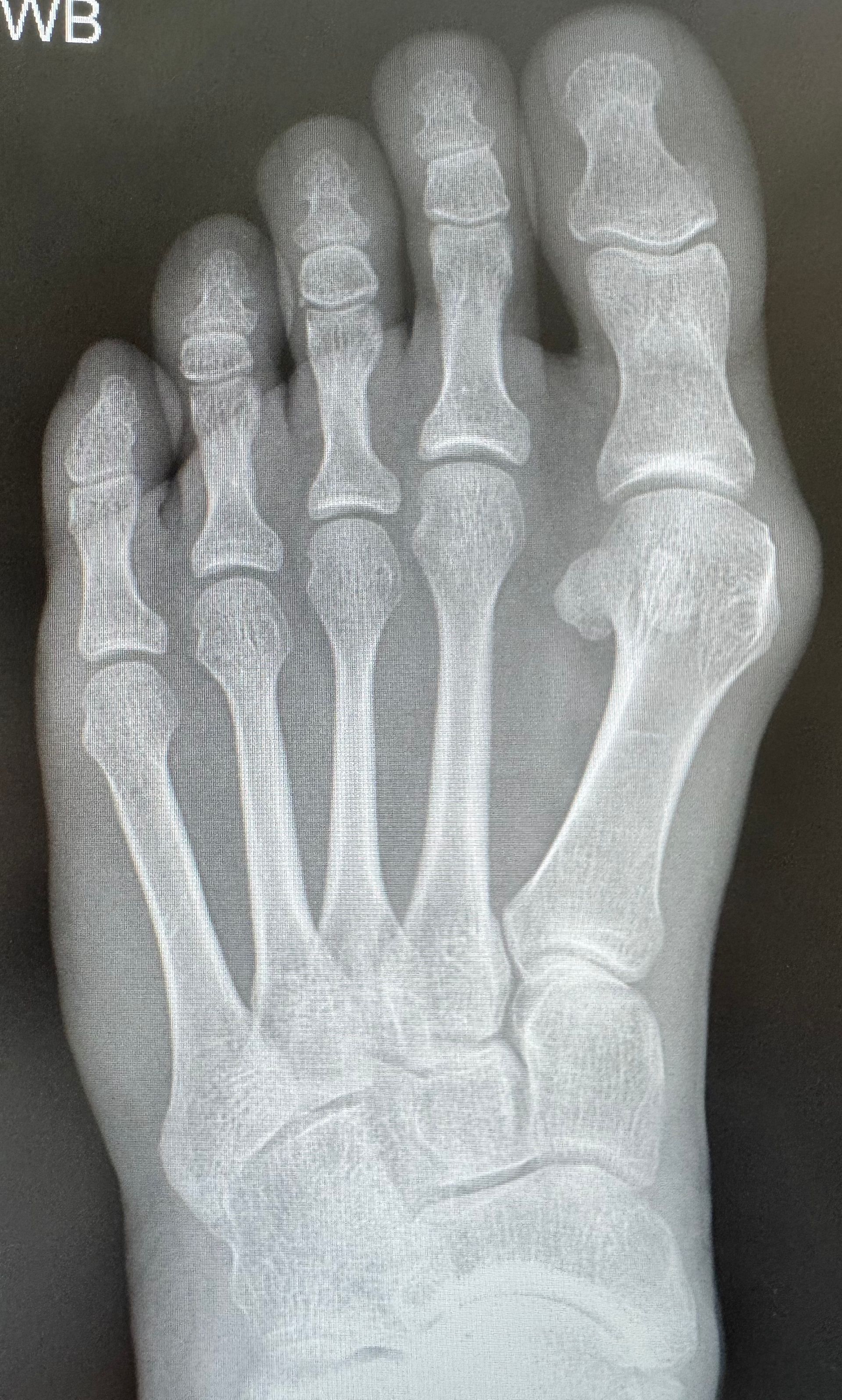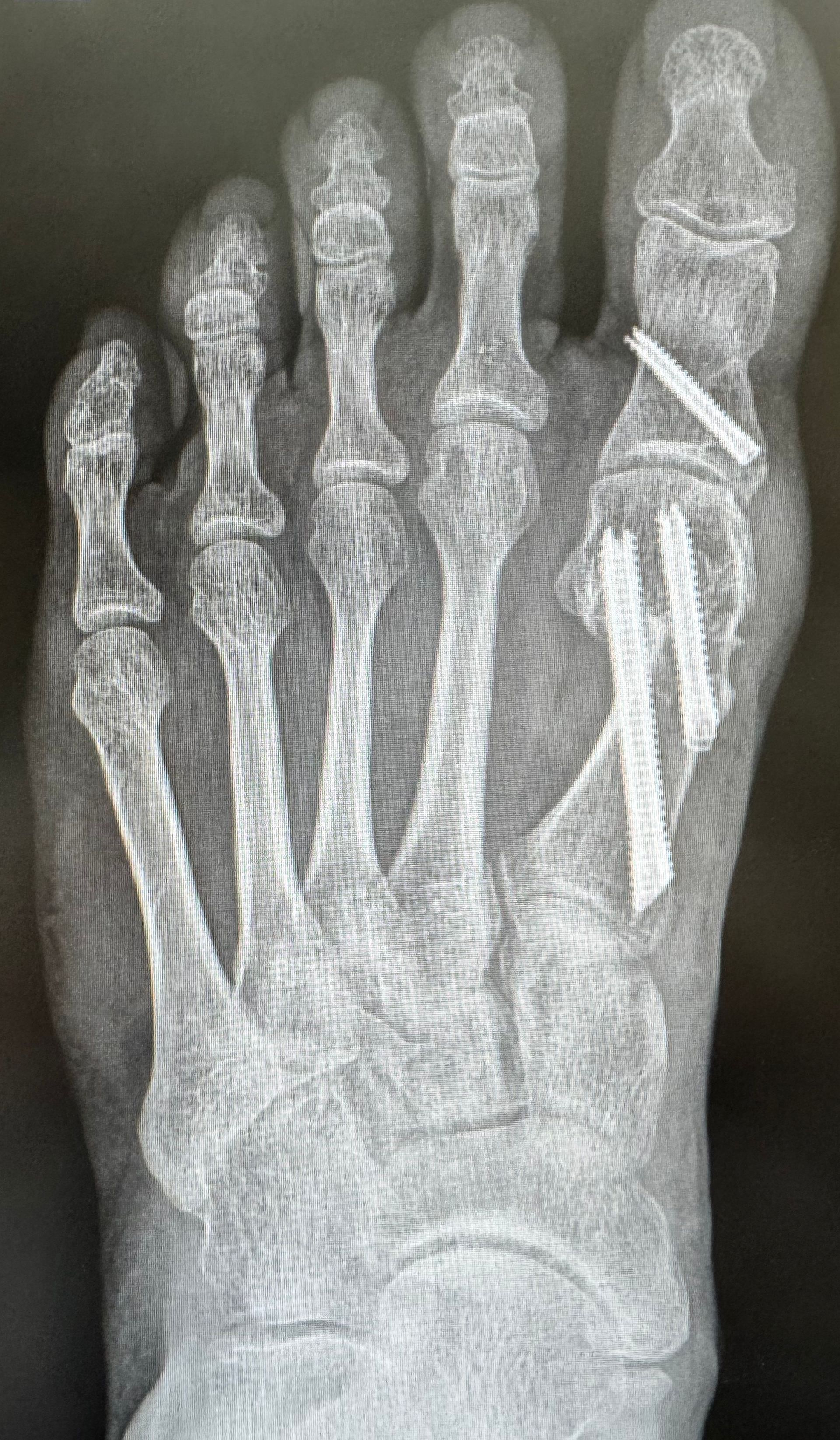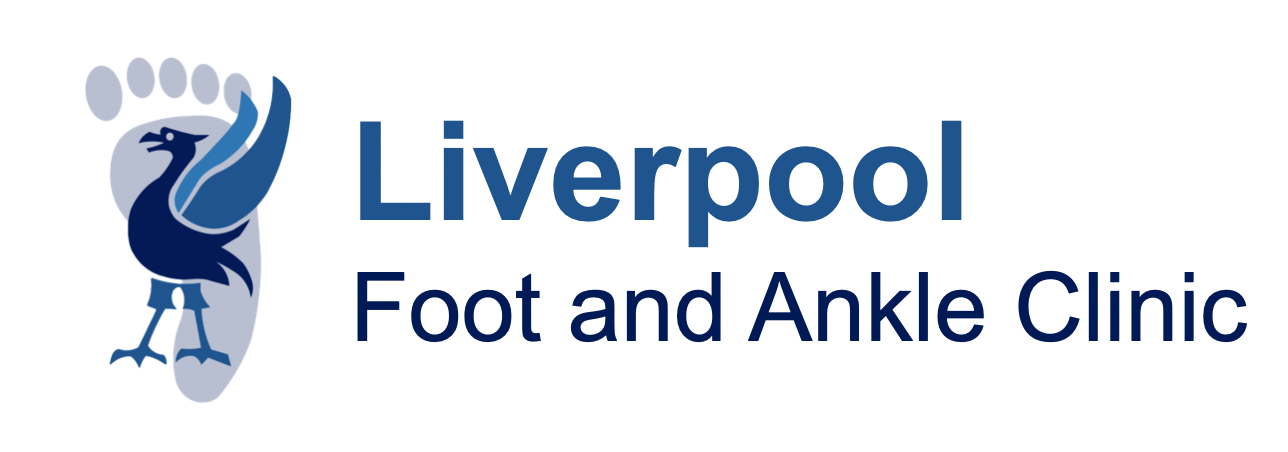
Prof Mason
Liverpool Foot and Ankle Clinic
To book an appointment, either email or phone the number below or click the link.
E-mail: CVDWclerical@outlook.com
Contact Patient Liaison: 07717580737
Bunion (Hallux Valgus)
Patient Information Regarding Bunion
What is a bunion?
A bunion, medically known as hallux valgus, is a bony bump that forms on the joint at the base of the big toe. It is a common foot deformity characterized by a deviation of the big toe towards the other toes, causing the base of the big toe to protrude outwards and the first metatarsal bone to stick outwards. This can cause pain, discomfort, and difficulty walking or wearing shoes.
The exact causes of hallux valgus are not well understood, but it is believed to be related to a combination of factors including genetics, foot shape and mechanics, and wearing tight or ill-fitting shoes.
What happens if I don't have treatment?
There is a possibility that nothing will happen. However, there are some if left untreated, can worsen over time and cause a number of complications. Some of the potential consequences of untreated hallux valgus include:
1. Increased pain and discomfort: As the condition progresses, the deformity can become more pronounced, causing more pain and discomfort when walking or wearing shoes.
2. Difficulty walking: The misalignment of the big toe can make it more difficult to walk properly and may result in a limp or altered gait.
3. Reduced mobility: In severe cases, the deformity can limit the range of motion of the big toe, making it difficult to perform certain activities.
4. Arthritis: The misalignment of the big toe can cause excess wear and tear on the joint, leading to arthritis and potentially causing further pain and stiffness.
5. Corns and calluses: The protruding bone and joint can cause friction against shoes, leading to the
development of corns and calluses.
6. Foot ulcers: In some cases, the pressure and friction caused by the deformity can result in the development of foot ulcers, which can be difficult to treat and may require surgery.
Therefore, it is important to seek treatment for hallux valgus, if problematic, to prevent further complications and improve your quality of life.
What treatments are available for hallux valgus?
The treatment for hallux valgus (bunion) depends on the severity of the condition and the amount of pain
and discomfort you experience.
Here are some common treatment options:
1. Change in footwear: Wearing shoes that are comfortable and have a wider toe box can help to reduce the pressure on the affected area and prevent further irritation.
2. Orthotics: Custom-made shoe inserts, pads, and arch supports can help to redistribute pressure and reduce pain, especially if the problem is in relation to a flattened arch.
3. Medications: Over-the-counter pain medications, such as paracetemol or nonsteroidal anti-inflammatory
drugs (NSAIDs), can help to reduce pain and inflammation.
4. Ice or heat: Applying ice or heat to the affected area can help to reduce swelling and relieve pain.
5. Exercises: Specific exercises to strengthen the foot and toe muscles can help to improve the
alignment of the toes and reduce pain.
6. Surgery: In more severe cases where conservative treatment is not effective, surgery may be
necessary to realign the joint and remove any bony protrusions.
It's important to note that hallux valgus is a progressive condition, meaning it tends to worsen over time. Therefore, early intervention and treatment is recommended to prevent further complications and alleviate symptoms.
What type of surgery can be undertaken for hallux valgus?


An osteotomy is a surgical procedure used to correct bone deformities by cutting and realigning the bone. In the treatment of hallux valgus, commonly known as a bunion, an osteotomy involves precisely cutting the bone of the big toe (the first metatarsal) to correct its abnormal angle. The bone segments are then realigned to their proper anatomical positions and usually secured with screws to maintain the correction during healing.
The advantages of osteotomy in treating hallux valgus include:
- Joint Preservation: Osteotomy preserves the natural joint, allowing for continued movement and functionality of the toe.
- Correction of Deformity: It directly addresses the structural deformity, realigning the bone to its proper position and improving the overall alignment of the foot.
- Pain Relief: By correcting the misalignment, osteotomy can alleviate the pain associated with hallux valgus, both at rest and during movement.
- Improved Aesthetics: The procedure can significantly improve the appearance of the foot, reducing the prominence of the bunion and leading to better fitting of shoes.
- Customization: Surgeons can tailor the osteotomy to the specific needs of the patient, adjusting the type and extent of the cut based on the severity of the deformity and other individual factors.
Overall, osteotomy is a versatile and effective option for many patients with hallux valgus, offering a balance between correction and preservation of foot function.


Fusion of 1st Metatarsophalangeal joint or Tarsometatarsal Joint
Fusion, also known as arthrodesis, is a surgical procedure that involves permanently joining two or more bones, removing the joint to eliminate movement between them. In the context of hallux valgus treatment, fusion typically targets the first metatarsophalangeal (MTP) joint, which is the joint at the base of the big toe. During the procedure, the surgeon removes the damaged cartilage and positions the bones in the correct alignment before securing them with screws, plates, or other fixation devices to facilitate bone healing into a single, solid unit.
The advantages of fusion in the treatment of hallux valgus include:
- Pain Relief: By eliminating the joint movement that causes pain, fusion can provide significant and long-lasting pain relief for patients with severe arthritis or deformity in the joint.
- Stability: Fusion offers excellent stability to the affected area, preventing further deformity and maintaining the correct alignment of the toe.
- Durability: The results of a fusion are typically very durable, making it a suitable option for patients with severe or recurrent hallux valgus that has not responded well to other treatments.
- Elimination of Deformity: Fusion can correct severe deformities effectively, especially in cases where the soft tissues and other structures around the joint have been extensively damaged.
- Reduced Recurrence: The likelihood of the deformity recurring after a fusion is lower compared to other surgical methods, as the joint is permanently fixed in the corrected position.
While fusion sacrifices joint mobility, it is a highly effective treatment for patients with significant joint degeneration (arthritis), severe deformity, or those who have failed previous corrective surgeries or are an increased risk of recurrence.


A keyhole bunion, also known as minimally invasive bunion surgery, is a less invasive surgical technique used to correct hallux valgus (bunions). This procedure involves making multiple very small incisions, through which specialized instruments are inserted to realign the bones and correct the deformity. The surgery is performed using imaging guidance, to ensure precise corrections without the need for large, open incisions.
The possible advantages of keyhole bunion surgery over traditional open surgery include:
- Smaller Incisions: The tiny incisions used in keyhole surgery result in less tissue damage, reduced scarring, and a possibly more cosmetically appealing outcome.
- Reduced Pain: Patients often experience less postoperative pain due to the minimally invasive nature of the procedure, leading to a more comfortable recovery.
- Faster Recovery: Minimally invasive surgery typically involves a quicker recovery time, allowing patients to return to their normal activities sooner than with open surgery.
- Lower Risk of Infection: Smaller incisions reduce the risk of infection and other complications associated with larger surgical wounds.
- Improved Mobility: Patients may experience better postoperative mobility and less stiffness due to the preservation of surrounding soft tissues and structures.
Overall, keyhole bunion surgery offers a less traumatic alternative to traditional open surgery, providing effective correction of the deformity with numerous benefits that enhance the patient's recovery and overall experience.


